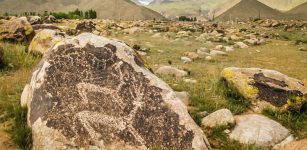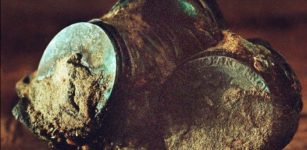Lake Titicaca Reveals More Ancient Underwater Secrets
AncientPages.com - Located in in the Andes on the border of Peru and Bolivia, Lake Titicaca is the largest lake in South America.
There are many tales about the lake containing underwater citadels and wealth and archaeologists are now beginning to discover some of the precious ancient objects hiding beneath the water.
A team of underwater archaeologists that participated in an expedition that began two months ago have just found a number of relics that are from different eras, both Inca era and pre-Inca (1438-1533).
Part of a discovery of pieces of gold, silver, bone and ceramics dated 1,500 years ago found on the Bolivian banks of the Titicaca lake by a group of Belgian archaeologists, in La Paz, on October 8, 2013.Aizar Raldes Nunez/AFP/Getty Images
"We found 2,000 objects and fragments," Christophe Delaere, the Belgian co-director of the Huinaimarca Project that unearthed the items, said at a ceremony in La Paz.
According to Delaere divers found the objects more than 20 feet (7 meters) underwater off the Island of the Sun.
Scienctists participating in the proiject unearthed 31 gold fragments, mainly around the Isla del Sol.
The legend holds that mythical founders of the Incan empire emerged from the lake's waters.
"There are ceramics and urns from more than 500 to 800 years ago," Delaere said. Among the objects were also 1,500-year-old objects such as stone vessels, incense containers and figures of animals like pumas.
Aizar Raldes Nunez/AFP/Getty Images
The divers examined various parts of the lake and were able to find objects from different epochs.
Part of a discovery of pieces of gold, silver, bone and ceramics dated 1,500 years ago found on the Bolivian banks of the Titicaca lake by a group of Belgian archaeologists, in La Paz, on October 8, 2013.
Several interesting objects were found in the lake.
Aizar Raldes Nunez/AFP/Getty Images
Archaeologists think these discoveries are just the beginning. More amazing ancient objects could be hidden at the bottom of the lake.
According to Colonel John Blashford-Snell the ancient city of Tiwanaku, near Lake Titicaca, copied their knowledge from the scientists of the mysterious legend 'Atlantis'. Plato wrote about this remarkable ancient city a long time ago and there are many myths and legends about the lost continent.
Today, with a modern-day town located nearby, Tiwanaku is a great ruin. "Massive, stone-faced earthen mounds rise from the plain; nearby are great rectangular platforms and sunken courts with beautiful cut-stone masonry," writes Denver Art Museum curator Margaret Young-Sánchez in her book "Tiwanaku: Ancestors of the Inca".
By the shores of Lake Titicaca, the largest body of water in the South American highland, rose the city of Tiwanaku. Its megalithic structures were constructed between AD 100 and 300. By 500 Tiwanaku had become the capital of an expanding empire in the Andes that endured until approximately AD 1000, when extended drought caused water levels to fall and agriculture to fail. After European colonization many of the buildings were raided for their stone, which was used to construct churches, rail stations, and houses. Less than a day s trip from La Paz, Bolivia, Tiwanaku remains one of the most impressive archaeological sites in South America.
Despite its fame and its economic, political, and artistic importance to such later peoples as the Incas, the Tiwanaku civilization has never been the subject of a comprehensive international art exhibition and accompanying catalog until now. Tiwanaku introduces American audiences to the striking artwork and fascinating rituals of this highland culture through approximately one hundred works of art and cultural treasures.
The range of media is unparalleled among ancient South American civilizations: large-scale stone sculptures, spectacular works in gold and silver, masterfully crafted ceramics, monumental architecture, gold and silver jewelry, and decoratively carved wood, bone, and stone objects. Of special note are the textiles, remarkably preserved by the dry climate of Tiwanaku s outposts in Chile and Peru. These finely crafted and richly decorated objects assembled from collections around the world evoke a vivid and comprehensive picture of elite life five hundred to one thousand years before the Inca Empire.
This lavishly illustrated, full-color catalog features insightful scholarly essays introducing the general reader to the culture and historical context of the Tiwanaku. Read more
It remains unknown when settlement at Tiwanaku began, but Young-Sánchez writes in her book that people in the Lake Titicaca area started settling permanently around 4,000 years ago.
In the late 1960s French explorer Jacques-Yves Cousteau conducted several expeditions in Lake Titicaca. Cousteau was diving for treasures. He said he was looking for 'The Pot of Gold' and he found signs of a civilization and today we are looking at some proof.
AncientPages.com
























